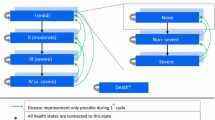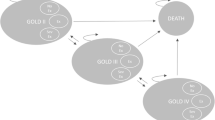Abstract
Rationale: Roflumilast is an oral, once-daily phosphodiesterase IV (PDE4) inhibitor under investigation for chronic obstructive pulmonary disease (COPD). This study investigated the cost effectiveness of roflumilast in patients with severe to very severe COPD from the perspective of the UK society and UK NHS.
Methods: The analysis was conducted alongside a 1-year, randomised, double-blind, placebo-controlled, multinational trial. The trial included 1514 COPD patients aged ≥40 years with a post-bronchodilator forced expiratory volume in 1 second (FEV1) % predicted =50% who were randomised to receive either roflumilast 500μg once daily (n = 761) or placebo (n = 753). Patients in both treatment groups were allowed to receive active treatment with a short-acting bronchodilator (salbutamol or anticholinergic) as needed. About 62% of patients in both groups were using an inhaled corticosteroid at trial entry. They were allowed to continue this on a stable dosage.
Direct healthcare and productivity costs were calculated. Resource utilisation was recorded at every scheduled visit in health economics case report forms (HECRFs). Trial-wide resource use was combined with UK unit cost (2004 values). Roflumilast was assumed to cost €1 per day. Incremental costs were related to the differences in the number of moderate to severe exacerbations and the net proportion of patients with an improvement of at least 4 units on the total score of the St George’s Respiratory Questionnaire (SGRQ). An intention-to-treat analysis was conducted. Costs and health outcomes that were missing after withdrawal of patients from the trial were imputed using multiple imputation with the propensity score method. Various sensitivity analyses were conducted to test the robustness of the data.
Results: In the total group, annual COPD-related costs from a societal perspective were €1637 in the roflumilast group and €1401 in the placebo group. From an NHS perspective, this was €1418 and €1242, respectively. The rate of moderate to severe COPD exacerbations per patient was low, and no statistically significant difference existed between roflumilast (0.96) and placebo (1.06). The net proportion of patients with a relevant improvement on SGRQ total score was higher in the roflumilast group (0.19) than in the placebo group (0.14), but the difference was not statistically significant. From a societal perspective, COPD-related costs were €2356 per exacerbation avoided and €4712 per net additional patient with a relevant improvement on the SGRQ. The probability that roflumilast was cost effective exceeded 70% at a willingness to pay of €5000 to avoid an exacerbation.
In a subgroup of patients with very severe COPD (n = 223), the placebo group had a high exacerbation rate (1.7 per patient per year) whereas roflumilast recipients showed 35% fewer exacerbations (1.1 per patient per year). This resulted in roflumilast dominating placebo. In a subgroup of patients with high healthcare utilisation prior to the study (n = 549) roflumilast recipients showed 19% fewer exacerbations than those receiving placebo, which translated into an ICER of €804 per exacerbation avoided.
Conclusion: Roflumilast increased the overall treatment costs of COPD, although the increase was partly offset by reductions in other forms of healthcare use. Roflumilast has the potential to be cost saving in patients with very severe COPD, due to a statistically significant reduction of exacerbations.









Similar content being viewed by others
References
Celli BR, MacNee W. Standards for the diagnosis and treatment of patients with COPD: a summary of the ATS/ERS position paper. Eur Respir J 2004; 23 (6): 932–946
Agusti AG, Noguera A, Sauleda J, et al. Systemic effects of chronic obstructive pulmonary disease. Eur Respir J 2003; 21 (2): 347–360
Vermeire P. The burden of chronic obstructive pulmonary disease. Respir Med 2002; 96 Suppl. C: S3–S10
GOLD: Global Initiative for Chronic Obstructive Lung Disease. Global strategy for diagnosis, management, and prevention of COPD. Bethesda (MD): National Institutes of Health, National Heart, Lung and Blood Institute, 2005
Feenstra TL, van Genugten ML, Hoogenveen RT, et al. The impact of aging and smoking on the future burden of chronic obstructive pulmonary disease: a model analysis in the Netherlands. Am J Respir Crit Care Med 2001; 164 (4): 590–596
Hoogendoorn M, Rutten-van Molken MPMH, Hoogenveen RT, et al. A dynamic population model of disease progression in COPD. Eur Respir J 2005; 26 (2): 223–233
Ruchlin HS, Dasbach EJ. An economic overview of chronic obstructive pulmonary disease. Pharmacoeconomics 2001; 19 (6): 623–642
Oostenbrink JB, Rutten-van Molken MPMH. Resource use and risk factors in high cost exacerbations of COPD. Respir Med 2004; 98: 883–891
Pauwels R, Lofdahl C-G, Pride N, et al. Long-term treatment with inhaled budesonide in persons with mild chronic obstructive pulmonary disease who continue smoking. N Engl J Med 1999; 340 (25): 1948–1953
Vestbo J, Sorensen T, Lange P, et al. Long-term effect of inhaled budesonide in mild and moderate chronic obstructive pulmonary disease: a randomised controlled trial. Lancet 1999; 353: 819–823
Burge PS, Calverley PMA, Jones PW, et al. Randomised, double blind, placebo controlled study of fluticasone propionate in patients with moderate to severe chronic obstructive pulmonary disease: the ISOLDE trial. BMJ 2000; 320: 1297–1303
LHSRG: Lung Health Study Research Group. Effect of inhaled triamcinolone on the decline in pulmonary function in chronic obstructive pulmonary disease. N Engl J Med 2000; 343: 1902–1909
Rabe KF, Bateman ED, O’Donnell D, et al. Roflumilast: an oral anti-inflammatory treatment for chronic obstructive pulmonary disease. A randomised controlled trial. Lancet 2005; 366 (9485): 563–571
Fabbri LM, Sanchez-Toril F, McIvor RA, et al. Effect of roflumilast on exacerbations: a 1-year study in patients with severe to very severe COPD [abstract]. Proc Am Thorac Soc 2006; 3: A 841
Calverley PM, Sanchez-Toril F, McIvor RA, et al. Effect of roflumilast on lung function: a 1-year study in patients with severe to very severe COPD [abstract]. Proc Am Thorac Soc 2006; 3: A 725
ATS: American Thoracic Society. Standardisation of spirometry, 1994 update. Am J Respir Crit Care Med 1995; 152: 1107–1136
Jones PW, Quirk FH, Baveystock CM, et al. A self-complete measure of health status for chronic airflow limitation: the St George’s Respiratory Questionnaire. Am Rev Respir Dis 1992; 145: 1321–1327
NHS Executive. NHS reference costs, 2003. Leeds: NHS, 2003 [online]. Available from URL: http://www.dh.gov.uk/en/Policyandguidance/Organisation policy/Financeandplanning/NH-Sreferencecosts/index.htm [Accessed 2005 Apr 15]
Curtis L, Netten A. Unit costs of health & social care 2004. Canterbury: Personal Social Services Research Unit, University of Kent, 2004 [online]. Available from URL: http://www.pssru.ac.uk/uc/uc2004.htm [Accessed 2005 Apr 15]
NHS Executive. NHS returns, 2003/2004. Leeds, NHS [online]. Available from URL: http://www.dh.gov.uk/en/Publicationsandstatistics/Statistics/index.htm [Accessed 2005 Apr 15]
Office of National Statistics. National statistics online [online]. Available from URL: http://www.statistics.gov.uk/CCI/nugget.asp?ID=19 [Accessed 2005 Apr 15]
European Central Bank. Euro foreign exchange reference rates [online]. Available from URL: http://www.ecb.int/stats/eurofxref/ [Accessed 2005 Apr 15]
Office of National Statistics. Labour force survey: historical quarterly supplement. [online] Available from URL: http://www.statistics.gov.uk/STATBASE/Source.asp?vlnk=358&More=Y [Accessed 2005 Apr 15]
Koopmanschap MA, Rutten FFH, van Ineveld BM, et al. The friction cost method for measuring indirect costs of disease. J Health Econ 1995; 14: 171–189
Oostenbrink JB, Bouwmans CAM, Koopmanschap MA, et al. Handleiding voor kostenonderzoek; methoden en standaard kostprijzen voor economische evaluaties in de gezondheidszorg. Diemen: College voor zorgverzekeringen, Geactualiseerde versie, 2004
Jones PW. Interpreting thresholds for a clinically significant change in health status in asthma and COPD. Eur Respir J 2002; 19 (3): 398–404
Rubin DB. Multiple imputation for nonresponse in surveys. 1st ed. New York: J. Wiley and Sons, 1987
Rubin DB, Schenker N. Multiple imputation in healthcare databases: an overview and some applications. Stat Med 1991; 10: 595–598
Schafer J. Analysis of incomplete multivariate data. 1st ed. London: Chapman and Hall, 1997
Briggs AH, Wonderling DE, Mooney CZ. Pulling cost-effectiveness analysis up by its bootstraps: a non-parametric approach to confidence interval estimation. Health Econ 1997; 6: 327–340
Rubin DB. Multiple imputation after 18+ years. J Am Stat Assoc 1996; 91: 473–489
Rosenbaum PR, Rubin DB. Reducing bias in observational studies using subclassification in the propensity score. J Am Stat Assoc 1984; 79: 516–524
van Hout BA, Al MJ, Gordon GS, et al. Costs, effects and c/eratios alongside a clinical trial. Health Econ 1994; 3: 309–319
Fenwick E, O’Brien BJ, Briggs A. Cost-effectiveness acceptability curves: facts, fallacies and frequently asked questions. Health Econ 2004; 13 (5): 405–415
Lothgren M, Zethraeus N. Definition, interpretation and calculation of cost-effectiveness acceptability curves. Health Econ 2000; 9 (7): 623–630
Decramer M, Gosselink R, Rutten-van Molken MPMH, et al. Assessment of progression of COPD: report of a workshop held in Leuven, 11–12 March 2004. Thorax 2005; 60: 335–342
Oostenbrink JB, Al MJ. The analysis of incomplete cost data due to dropout. Health Econ 2005; 14 (8): 763–776
Lin D, Feuer E, Etzioni R, et al. Estimating medical costs from incomplete follow-up data. Biometrics 1997; 53: 419–434
Oostenbrink JB, Rutten-van Molken MPMH, Al MJ, et al. One-year cost-effectiveness of tiotropium versus ipratropium to treat chronic obstructive pulmonary disease. Eur Respir J 2004; 23: 241–249
Briggs AH, Lozano-Ortega G, Spencer S, et al. Estimating the cost-effectiveness of fluticasone propionate for treating chronic obstructive pulmonary disease in the presence of missing data. Value Health 2006; 9 (4): 227–235
Sin DD, Golmohammadi K, Jacobs P. Cost-effectiveness of inhaled corticosteroids for chronic obstructive pulmonary disease according to disease severity. Am J Med 2004; 116 (5): 325–331
Lofdahl CG, Ericsson A, Svensson K, et al. Cost effectiveness of budesonide/formoterol in a single inhaler for COPD compared with each monocomponent used alone. Pharmacoeconomics 2005; 23 (4): 365–375
Calverley PMA, Celli BR, Anderson JA, et al. The TORCH (Towards a Revolution in COPD Health) study: salmeterol/ fluticasone propionate (SFC) improves survival in COPD over three years [abstract no. E311]. Eur Respir J 2006; 28: S50
Drummond MF, Pang F. Transferability of economic evaluation results. In: Drummond MF, McGuire A, editors. Economic evaluation in health care: merging theory with practice. 1st ed. Oxford: Oxford University Press, 2001
Pang F. Design, analysis and presentation of multinational economic studies: the need for guidance. Pharmacoeconomics 2002; 20 (2): 75–90
Sculpher MJ, Pang FS, Manca A, et al. Generalisability in economic evaluation studies in healthcare: a review and case studies. Health Technol Assess 2004; 8 (49): iii–iv, 1–192
Willke RJ, Glick HA, Polsky D, et al. Estimating country-specific cost-effectiveness from multinational clinical trials. Health Econ 1998; 7: 481–493
Grieve R, Nixon R, Thompson SG, et al. Using multilevel models for assessing the variability of multinational resource use and cost data. Health Econ 2005; 14 (2): 185–196
Manca A, Rice N, Sculpher MJ, et al. Assessing generalisability by location in trial-based cost-effectiveness analysis: the use of multilevel models. Health Econ 2005; 14 (5): 471–485
Acknowledgements
The authors wish to acknowledge the support of their colleagues Dr Jan Oostenbrink, Dr Michel van Agthoven and Dr Maiwenn Al. We also thank ALTANA Pharma AG in Konstanz, Germany, for initiating and sponsoring this cost-effectiveness analysis.
The sponsor designed the clinical trial, managed the logistics of this clinical trial and collected the data. The cost-effectiveness study and the HE-CRF were designed in a combined effort. Data entry was performed by Omninare in Germany. Data was analysed and interpreted by the first two authors, who also wrote the manuscript. All other authors contributed to writing and reviewing the manuscript and approved it. All errors and omissions remain the authors’ responsibility.
The Institute for Medical Technology Assessment has a consultancy agreement with ALTANA Pharma AG. The first two authors and the last author do not hold stock or other equities in pharmaceutical companies. The last author has received honoraria and consultancy fees from ALTANA Pharma AG. The fourth author holds stock options in ALTANA Pharma AG.
Author information
Authors and Affiliations
Corresponding author
Rights and permissions
About this article
Cite this article
Rutten-van Mölken, M.P.M.H., van Nooten, F.E., Lindemann, M. et al. A 1-Year Prospective Cost-Effectiveness Analysis of Roflumilast for the Treatment of Patients with Severe Chronic Obstructive Pulmonary Disease. Pharmacoeconomics 25, 695–711 (2007). https://doi.org/10.2165/00019053-200725080-00007
Published:
Issue Date:
DOI: https://doi.org/10.2165/00019053-200725080-00007




